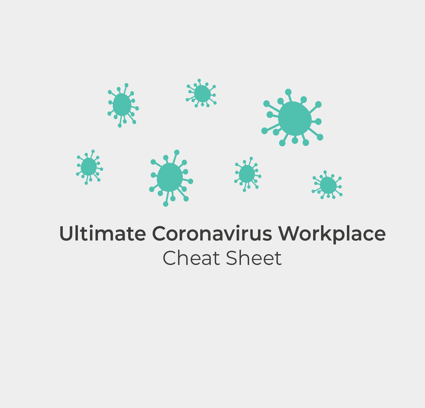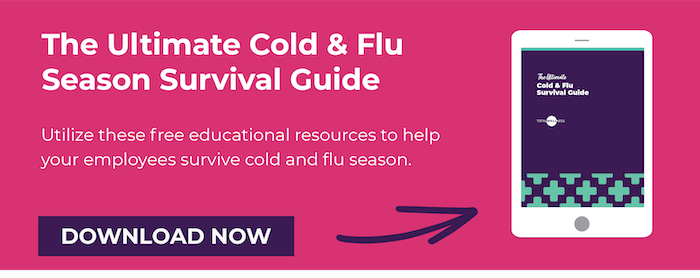 Coronavirus is making headlines left and right.
Coronavirus is making headlines left and right.
As dizzying as it is to read the daily updates, it’s important for employers to keep common-sense policies in practice during these uncertain times.
That doesn’t mean employers need to panic, but it is a chance to educate.
Coronavirus — also known as COVID-19 — is a new disease that causes symptoms similar to the common cold. The reason it’s spreading so quickly is that even if a host is carrying it, they may not present symptoms for several days. The virus can also live on surfaces for up to nine days, making it easily transmittable to others.
Want the facts about the virus?
Below, you’ll find your coronavirus cheat sheet for dealing with this health issue in the workplace.
Coronavirus and the Workplace: What You Need to Know
Unfortunately, in the last few weeks, the outbreak of the coronavirus is causing political, economic, and social upset in a variety of ways.
To date, 100 countries have reported an outbreak or COVID-19, including the United States. The virus is “SARS-CoV-2” but the disease it causes is called “coronavirus disease 2019” or COVID-19.
Schools and workplaces have shut down, entire countries have quarantined residents, and everyday commodities like hand soap are selling out everywhere.
The World Health Organization (WHO) has declared it a pandemic, but it’s not a reason for workers to panic. Below, we share the science-backed facts of how to tackle this topic at work.
What are the Symptoms of Coronavirus?
Individuals who are feeling unwell in the upcoming months should carefully monitor their symptoms. A test became available mid-January for the coronavirus, so those who believe they have it may be properly diagnosed. You may feel body aches and have a fever at the onset of the virus.
The following symptoms often appear two to 14 days after exposure:
- Fever
- Cough
- Shortness of breath
Emergency warning signs of COVID-19 require immediate medical attention. These may include:
- Bluish lips or face
- New confusion
- Inability to waken
- Persistent chest pain or pressure
- Difficulty breathing or breath shortness
For any other symptoms, call your nurse line or visit your primary doctor. This will free up space in emergency departments for those who are dealing with serious illness.
Important note: Most people recover from COVID-19. About 80% of those who contract it will have mild symptoms, according to a recent World Health Organization (WHO) report.
Why Sick Employees Need to Stay Home
The most important aspect of COVID-19 to understand is that it’s easily transmitted.
While a typical “cold-like” illness may not be a problem for healthy individuals, it can cause serious illness or death for others.
The common thread among those who have died from the virus is they had underlying health issues that were further complicated by the virus. This means if an otherwise healthy employee has the sniffles and a slight fever, they could still potentially spread this virus. It could be picked up by another employee who could be seriously compromised. They may be taking care of an unwell elderly parent or have health issues themselves.
People with severe underlying chronic medical conditions like heart or lung disease or diabetes are more susceptible to catching this virus. Same goes for elderly individuals.
That’s why it’s a must during this time to send sick employees home.
As of March 16, 2020, there were 69 deaths of the 3,813 confirmed cases in the United States.
For perspective, between October 2019 through March 2020, between 20,000 to 52,000 individuals died from influenza. While there is a flu shot available, no known vaccine is available for coronavirus at this time.
Who Should Stay Home
According to the Centers for Disease Control and Prevention (CDC), anyone with symptoms of acute respiratory illness are recommended to stay home. No matter what illness your workers are facing, it’s best to have them work from home, if possible.
These individuals shouldn’t come into work until they are:
- Fever-free (which is considered 100.4° F or greater)
- Have no signs of a fever (chills, sweats, etc.)
- Don’t show any other symptoms
- Are no longer using fever-reducing medications
Once an individual has 24 hours symptom-free, they can return to work.
How to Keep Your Workplace Safe From an Outbreak
There are some common-sense practices employers and employees can take to avoid the spread of any virus at work. Additionally, flu season still isn’t over, so your workplace may be battling with multiple strains of illness.
Here’s a look at how to protect your employees while still keeping your business afloat:
- Encourage sick employees to stay at home - If anyone comes in coughing, sneezing, or looking generally unwell, send them home ASAP. The coronavirus can live on surfaces for almost 10 days, so it’s important to minimize spreading it.
- Minimize large gatherings - If possible, host remote meetings. Don’t gather in auditoriums, tight meeting rooms, or cramped offices for even “brief” meetings. Use email for company updates and tech options like Zoom to host mandatory meetings.
- Sanitize everything - Every day, have a cleaning crew sanitize surfaces like tables, desks, door handles, fridge and microwave handles, and phones once employees leave for the day. Keep hand sanitizer and disposable wipes around for employees to use.
- Stop all potlucks and catered lunches - If your team is fond of lunch gatherings, consider temporarily suspending these. People don’t wash their hands as well as they should, and if they’re diving into a community chip bowl, you can expect a quick spread of illness.
- Build-in new policies - Because the severity of the outbreak is unknown right now, it’s smart to plan ahead anyway. In the event that your workplace may need to be shut down, plan ahead for how workers may be able to work remotely. Get the tech in place, set up ideal communication methods, and work schedule policies now.
Check out the Centers for Disease Control and Prevention interim guidance for dealing with coronavirus in the workplace.
Illness Prevention Tips to Share With Employees
Again, handling the coronavirus situation in the workplace comes down to mostly using common sense.
There are always those employees who want to power through and seem stoic when they’re sick by coming in. Remind these employees of your current sick policies and coach them on leave use.
A few strategies everyone in your workplace can use now:
- Wash hands - One of the best methods for preventing the spread of disease is good handwashing hygiene and technique. After smoking, sneezing, coughing, using the bathroom, or getting hands dirty, wash and scrub in warm water for 30 seconds.
- Avoid handshakes - Make it a temporary personal and professional policy that individuals don’t shake hands. Fist bumps or simple hand waves can work just fine.
- Don’t touch your face - We touch our faces way more than we think about — up to 100 times a day sometimes — and it’s a prime way to get sick. You may unknowingly have touched a contaminated surface and then scratch your nose. Hands down.
- Watch where you sneeze - Sneeze into your elbow — not your hands — when a tissue is unavailable. It’s best to use a tissue and then immediately toss it upon use.
- BYOP - This idea is a must: Bring Your Own Pen (BYOP) wherever you go. Don’t use a coworker’s pen, the bank pens, or anyone else’s writing utensils. Keep your own on you and don’t lend it out, either.
- Increase supplement use - Daily, take liposomal vitamin C twice daily (this comes as 1000 or 1200 mg), which is easier for the body to absorb. Increase intake to four or five times daily if you feel like you’re coming down with an illness. Take your multivitamin, too.
- Keep hand sanitizer use to a minimum - Unfortunately, hand sanitizer doesn’t remove all germs. Soap and water are still most effective at removing germs like Cryptosporidium and norovirus. But when you don’t have access to water and soap, use a hand sanitizer that’s at least 60% alcohol.
- Sanitize when needed - Get into the habit of wiping down items with sanitizer. This goes for cell phones, desk phones, keyboards, arm rests, and other equipment. A paper towel with bleach spray or a disposable wipe is best to get the job done.
How is your workplace handling the coronavirus outbreak and concern? Let us know in the comments below!



